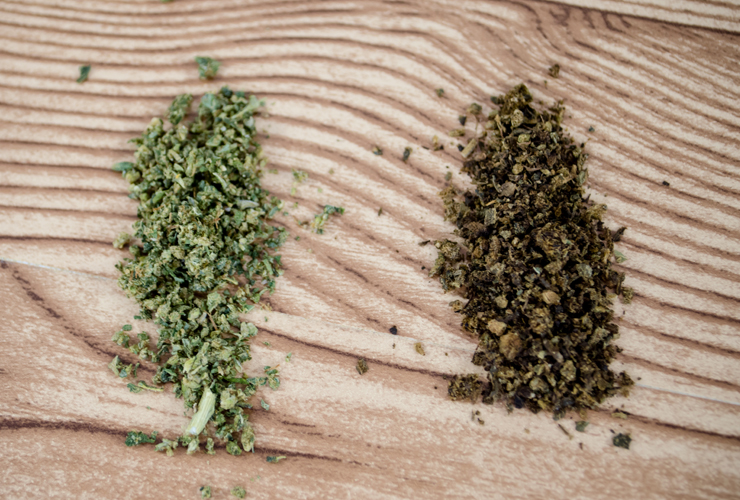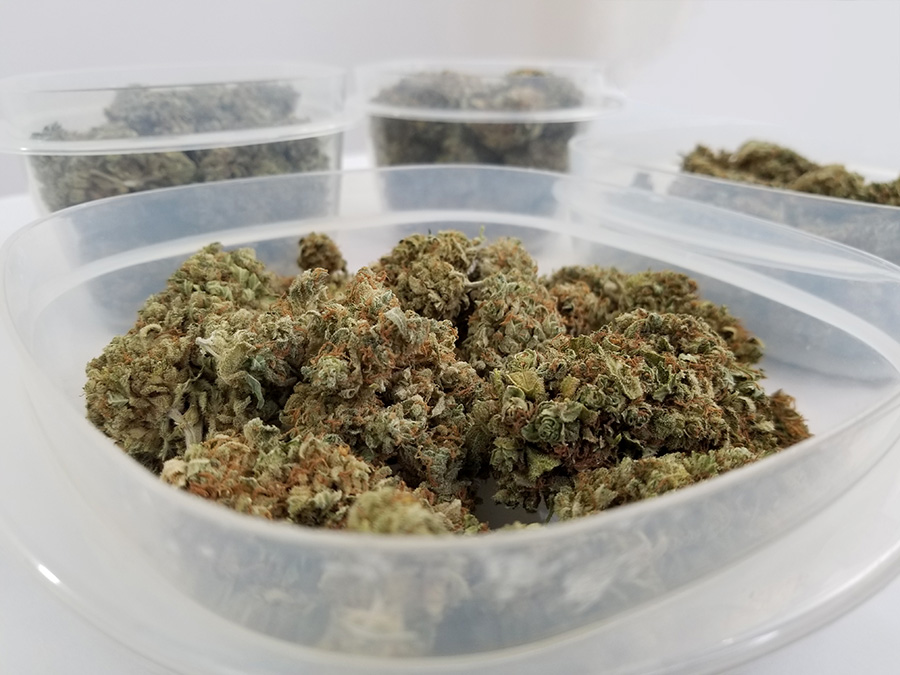Decarboxylation is the magic that makes cannabis a potent additive to food.
Simply put, it’s a chemical reaction that is achieved through heating up raw cannabis to a temperature at which it releases a carboxyl group and becomes psychoactive.
THCA (Tetrahydrocannabinolic acid) is the active component in raw cannabis, and it’s not a psychoactive compound by default.
Through decarboxylation, we’re essentially applying heat to plant material so that the THCA gets converted to THC, enabling us to get high.
Chemistry of decarboxylation

Cannabinoids in raw cannabis have an extra carboxyl ring in their molecular structure.
For the purposes of this article, we’ll focus on the two most prevalent: THC and CBD.
This extra carboxyl group gets removed in the process of decarboxylation due to the effect heat has on their chemical structure.
Once enough heat has been applied, the molecule will release a carboxyl group. That carboxyl group then gets replaced with a hydrogen molecule.
Knowing When to Decarb Weed
If you’re hoping to get the most from your cannabis, decarbing is essential. Decarboxylation is the only way to achieve a strong psychoactive effect from your herb. Yet, apart from simply taking a lighter to a bowl, where’s when it’s useful to decarb:
- Prior to making infused oils, edibles, drinks and foods.
- Prior to making tinctures.
- Prior to adding cannabis concentrates to edibles and drinks.
- After making full-extract extractions at home.
While decarbing is necessary to tap into the cannabis plant’s mind-altering nature, a psychoactive experience isn’t always appropriate for everyone. Fortunately, for those hoping to tap into the healing potential of cannabis without the high, there is some benefit to keeping things raw. The cannabinoid acids found in uncured and unheated cannabis plants may not be as well-researched as THC, but they are not without their benefit.
Early research in the lab suggests that THCA may be useful as an anti-nausea and anti-inflammatory aid. Virtually no human trials, however, examine just how effective THC-acid can be. Though, many medical patients use fresh cannabis in juices and smoothies to take full advantage of the potential benefits cannabinoid acids may provide.
Do You Decarboxylate CBD?
Just like THC, only trace amounts of activated CBD exists on the fresh cannabis plant. Instead, consumers can expect high quantities of CBD-acid. Like THC-acid, the acid form of CBD is less bioavailable than the decarboxylated stuff. While there may be many undiscovered benefits of CBDA, it’s the decarboxylated stuff that you’ll find in the tinctures and infused oils often sold online.
The exception is often isolated CBDA crystalline, which is a purified extraction of CBD. Like all cannabinoid acids, CBDA crystalline will transform into CBD when heated via baking, dabbing, vaporization, and smoking. Those hoping to supplement with the raw extraction, however, may be able to melt CBDA crystals in a warm beverage like coffee or tea without triggering a full decarboxylation reaction.
A full decarboxylation can happen at various temperatures over prolonged periods of time. CBDA crystalline can melt in your average cup of coffee, but that won’t equate to a cup full of CBD. In order to decarboxylate CBDA at such a low temperature, you would need to heat the crystals in your coffee for several hours. With a hotter temperature, like those achieved with a vaporizer, you can expect a fast decarboxylation reaction with any CBDA extraction.
How to Decarb Weed

When you’re smoking and vaporizing cannabis, decarboxylation occurs as soon as you add heat. If you’re hoping to decarboxylate before cooking, however, some additional steps are required. But, don’t worry. Decarbing right in your own kitchen is easy!
Decarboxylating your herb prior to cooking is a must for those hoping to make truly high-quality edibles. The good news? You can decarboxylate both cannabis flower and concentrates in your oven. Once the cannabis material has been activated, you can use it to infuse butter, oils, alcohols, fatty beverages, or simply use it as a psychoactive spice the next time you make some pasta. Before diving into the nitty-gritty on how to decarb cannabis, this time table acts as a reference for various common methods:
Table: Decarboxylation Temperatures and Times
| Temperature | Heating Mode | Plant Material Time | Kief / Hash Time | Cannabis Oil |
|---|---|---|---|---|
| 310F | Oven | 10 – 18 minutes | 5 – 10 minutes | |
| 250F | Hot oil bath | Until bubbles taper off | ||
| 240F | Oven | 50 – 60 minutes | 30 – 40 minutes | |
| 212F | Boiling water bath | 90 minutes | 90 minutes |
Following the timetable works best, of course, when your cannabis material is prepared and handled in just the right way. When decarbing, there are a couple of key things to keep in mind. One of the most important is temperature. The lower the temperature, the longer it’s going to take to decarb your cannabis. Keep in mind that a lower temperature will allow you to lose fewer terpenes. Terpenes are the pungent oils that color your cannabis with distinctive flavors such as berry, mint, citrus, and pine. There are many medicinal benefits to terpenes; some will successfully relieve your stress while others will promote focus and awareness. In order to maintain the aromatic integrity of your flower, the following is a general guide to decarboxylation:
Materials:
- Coarsely ground cannabis (chunks should be on the larger side).
- Baking tray with raised edges
- Parchment paper
- Wooden spoon or spatula
- Oven mitt
- Oven thermometer
How To Decarboxylate Marijuana:
- Preheat your oven to 240◦F (approximately 115.5◦C).
- Make sure you have an oven thermometer to give you an exact reading of the internal oven temperature. This is very important. Depending on the type of cannabis, your timing may vary, so stay close to the oven to look for signs of high heat and burning. A difference of 10◦ could burn the cannabis.
- Line your baking sheet with parchment paper.
- Evenly distribute your coarsely ground cannabis on your baking pan. Spacing the cannabis out is necessary to ensure the heat is evenly distributed.
- Toast the cannabis for a total of 40 minutes. Check on your herb at 20 minutes and gently stir. Check again at 30 minutes and take the herb out as soon as soon as it begins to develop a light, toasted coloration.
As a general rule of thumb, make sure not to leave the oven door open for too long when checking your cannabis. The heat will quickly escape and you decrease your likelihood of developing an even decarboxylation reaction. Your herb will gradually change color as it toasts. The cannabis should go from a vibrant green to a golden brown or dark green color.
As simple as this recipe sounds, if you want to completely cut down on the hassle, we recommend the MagicalButter machine, the easiest way to make cannabutter at home.